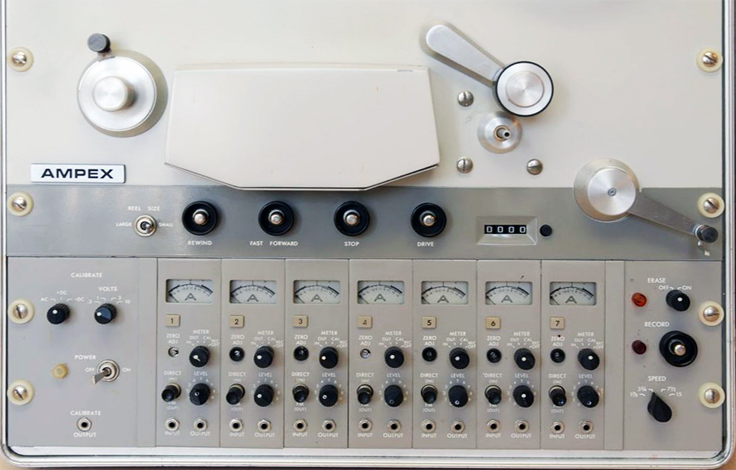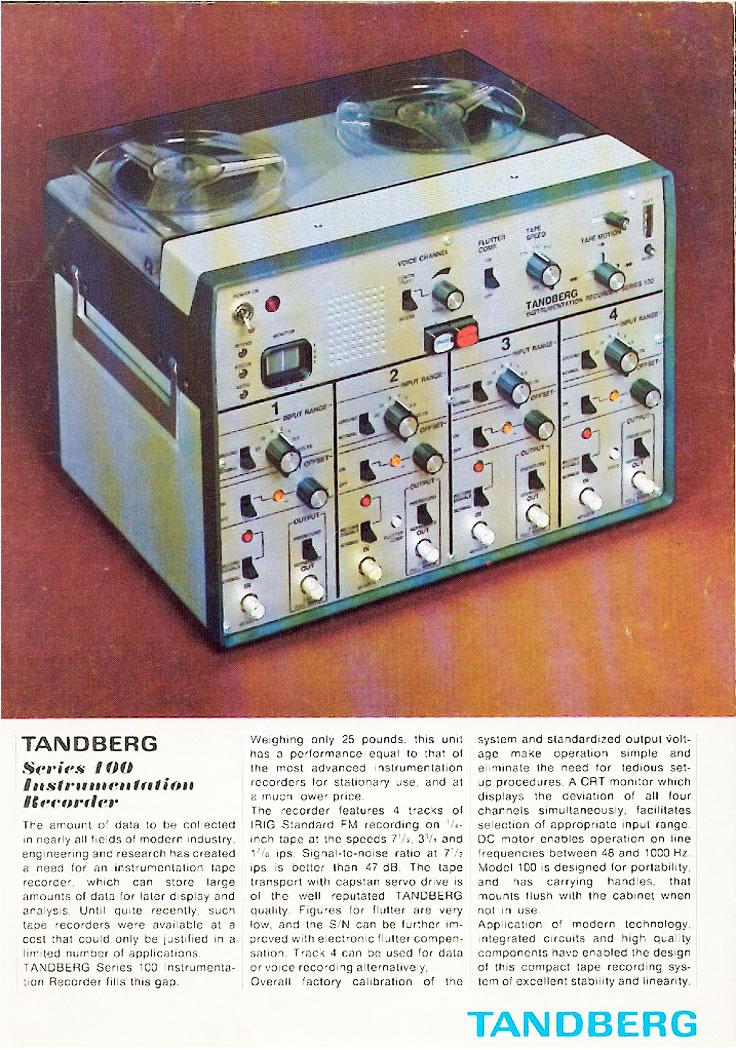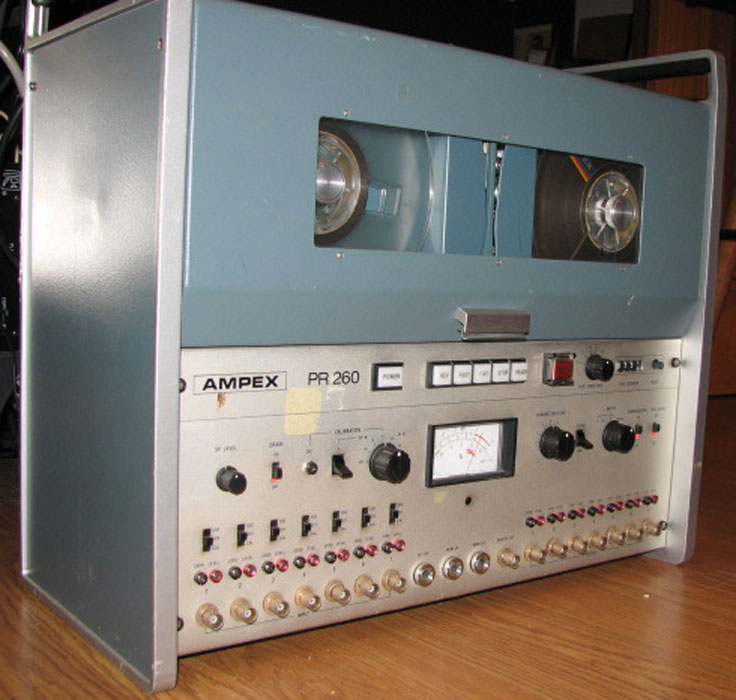
Science
Please help us make creating this museum a reality by
Supporting US!
© 2014 MultiMedia Museum • Museum of Magnetic Sound Recording

 |
Science Please help us make creating this museum a reality by © 2014 MultiMedia Museum • Museum of Magnetic Sound Recording |
 |
||
News coverage #1 • News coverage #2 • News coverage #3 •view trailer of the 7 hour collectionOur MOMSR collection is available in a 7 hour video production divided by manufacturer and downloadable for $9.95 at this link
view trailer of the 7 hour collection
Folks are often surprised to learn that almost 50% of the professional reel to reel tape recorders were used in industry for data collection. This included science (NASA), law enforcement radio logging, medical record tracking, oil field seismic logging and many other critical fields.


Instrumentation Data Multi-Track reel tape recorders
Many folks are not aware that many of the professional reel tape recorders that Ampex and Magnecord produced were "data" or "instrumentation" recorders.The US Defense Department and NSA were early adapters. Here's a declassified document from the NSA detailing the development of magnetic tape recording with NSA. Here's an excerpt from the NSA document
"In the quarter-century following the end of World War'll, the role of magnetic recorders in COMINT activities went from that of nonexistence to being an essential, critical component. During this era magnetic tape recorder technology moved through much the same sort of ferment and rapid advancement that computers demonstrated in the succeeding generation.: At base, the tape recorder made possible the off-line, riot-real-time processing of intercepted signals. As the quantity of targeted signals increased arid theri structures became more sophisticated and more complex, the necessity for equally sophisticated, complex analysis and processing at NSA Washington and other rear-echelon locations became absolute". Read the entire document from the NSA
IBM's first magnetic tape data storage devices (right), introduced in 1952, use what is now generally known as 7 track tape. The magnetic tape is 1/2" wide and there are six data tracks plus one parity track for a total of seven parallel tracks that span the length of the tape. Data is stored as six-bit characters, with each bit of the character and the additional parity bit stored in a different track.
These tape drives were mechanically sophisticated floor-standing drives that used vacuum columns to buffer long U-shaped loops of tape. Between active control of powerful reel motors and vacuum control of these U-shaped tape loops, extremely rapid start and stop of the tape at the tape-to-head interface could be achieved. When active, the two tape reels thus fed tape into or pulled tape out of the vacuum columns, intermittently spinning in rapid, unsynchronized
bursts resulting in visually striking action. Stock shots of such vacuum-column tape drives in motion were widely used to represent "the computer" in movies and television.
The Tandberg 100 left is an 8 track instrumentation/data recorder using 1/4" tape. Almost 50% of the professional reel to reel tape recorders produced were used in data recording. Users included the military, radio and television, 9-11 call centers, hospitals, the petroleum industry and many more. Magnetic tape continues to be used for data recording, although mostly it is cartridge based.
The Teac XR-7000 (below) is a 21 channel instrumentation recorder. Frequency: 40kHz - Dual display modes: bar-graph for all data channels or 2CH waveform display.- XR-7000 FM Wide Band Group-I recording, plus High Band recording, which doubles Wide Band Group-I response to DC 40kHz. - ID information recording and search functions speed data processing. Recording/reproduction is possible for up to 5 hours 44minutes with the XR- 7000. TEAC WX-7064 (far right)
Brüel & Kjær was founded by Per Vilhelm Brüel (b. March 6, 1915) and Viggo Kjær (b. June 5, 1914) on November 28, 1942. The two men met while studying at the The Polytechnic School in Copenhagen (now the Technical University of Denmark). After receiving their M.S. degrees in 1939 they decided to start a company developing instruments for acoustic measurements. Holger Nielsen joined the company as third partner in 1945, and was with the company until his death in 1978.
Brüel & Kjær is known for the green color of its instruments, but where did the color come from? The first instruments were fabricated by Brüel and Danish army technicians at the radio workshop in 1942. The light-green lacquer used for theinstrument front panels and dark green for the cabinets were standard Danish military colors and, of course, the paint was readily available, they have continued this color scheme to this day.
Lyrec 1972 TR86 Instrumentation recorder, 8-track on 1/4" (left). TR53-16 Multitrack recorder 16 tracks on 2" tape. TDU7202 Digital delay line. One of the first commercially available delay lines on the market.
Hewlett-Packard-HP-3964A-Instrumentation reel to reel tape recorder.
Go to sound recording's impact on Broadcasting • Education • Film • Music
© 2013 MultiMedia Museum • Museum of Magnetic Sound Recording
Tour our collection!
There are 50 QuickTime H264 854 X 480 files in this download. Play on MAC OS or Windows Media Player While most content deals with the history and manufacturers of the reel to reel tape recorder, or tape deck, we cover many aspects of magnetic recording.
© 2018 Museum of Magnetic Sound Recording • Webmaster • All pictures and content on this web site are the property of the Theophilus family,the Museum of Magnetic Sound Recording and reel2reeltexas.com • Photos of items in our collection are available for sale. We do NOT provide copies of ads, nor photos from other sources! All photo work is billed at studio rates and a deposit is required.
|